- Privacy Policy

Home » Scope of the Research – Writing Guide and Examples

Scope of the Research – Writing Guide and Examples
Table of Contents

Scope of the Research
Scope of research refers to the range of topics, areas, and subjects that a research project intends to cover. It is the extent and limitations of the study, defining what is included and excluded in the research.
The scope of a research project depends on various factors, such as the research questions , objectives , methodology, and available resources. It is essential to define the scope of the research project clearly to avoid confusion and ensure that the study addresses the intended research questions.
How to Write Scope of the Research
Writing the scope of the research involves identifying the specific boundaries and limitations of the study. Here are some steps you can follow to write a clear and concise scope of the research:
- Identify the research question: Start by identifying the specific question that you want to answer through your research . This will help you focus your research and define the scope more clearly.
- Define the objectives: Once you have identified the research question, define the objectives of your study. What specific goals do you want to achieve through your research?
- Determine the population and sample: Identify the population or group of people that you will be studying, as well as the sample size and selection criteria. This will help you narrow down the scope of your research and ensure that your findings are applicable to the intended audience.
- Identify the variables: Determine the variables that will be measured or analyzed in your research. This could include demographic variables, independent variables , dependent variables , or any other relevant factors.
- Define the timeframe: Determine the timeframe for your study, including the start and end date, as well as any specific time intervals that will be measured.
- Determine the geographical scope: If your research is location-specific, define the geographical scope of your study. This could include specific regions, cities, or neighborhoods that you will be focusing on.
- Outline the limitations: Finally, outline any limitations or constraints of your research, such as time, resources, or access to data. This will help readers understand the scope and applicability of your research findings.
Examples of the Scope of the Research
Some Examples of the Scope of the Research are as follows:
Title : “Investigating the impact of artificial intelligence on job automation in the IT industry”
Scope of Research:
This study aims to explore the impact of artificial intelligence on job automation in the IT industry. The research will involve a qualitative analysis of job postings, identifying tasks that can be automated using AI. The study will also assess the potential implications of job automation on the workforce, including job displacement, job creation, and changes in job requirements.
Title : “Developing a machine learning model for predicting cyberattacks on corporate networks”
This study will develop a machine learning model for predicting cyberattacks on corporate networks. The research will involve collecting and analyzing network traffic data, identifying patterns and trends that are indicative of cyberattacks. The study aims to build an accurate and reliable predictive model that can help organizations identify and prevent cyberattacks before they occur.
Title: “Assessing the usability of a mobile app for managing personal finances”
This study will assess the usability of a mobile app for managing personal finances. The research will involve conducting a usability test with a group of participants, evaluating the app’s ease of use, efficiency, and user satisfaction. The study aims to identify areas of the app that need improvement, and to provide recommendations for enhancing its usability and user experience.
Title : “Exploring the effects of mindfulness meditation on stress reduction among college students”
This study aims to investigate the impact of mindfulness meditation on reducing stress levels among college students. The research will involve a randomized controlled trial with two groups: a treatment group that receives mindfulness meditation training and a control group that receives no intervention. The study will examine changes in stress levels, as measured by self-report questionnaires, before and after the intervention.
Title: “Investigating the impact of social media on body image dissatisfaction among young adults”
This study will explore the relationship between social media use and body image dissatisfaction among young adults. The research will involve a cross-sectional survey of participants aged 18-25, assessing their social media use, body image perceptions, and self-esteem. The study aims to identify any correlations between social media use and body image dissatisfaction, and to determine if certain social media platforms or types of content are particularly harmful.
When to Write Scope of the Research
Here is a guide on When to Write the Scope of the Research:
- Before starting your research project, it’s important to clearly define the scope of your study. This will help you stay focused on your research question and avoid getting sidetracked by irrelevant information.
- The scope of the research should be determined by the research question or problem statement. It should outline what you intend to investigate and what you will not be investigating.
- The scope should also take into consideration any limitations of the study, such as time, resources, or access to data. This will help you realistically plan and execute your research.
- Writing the scope of the research early in the research process can also help you refine your research question and identify any gaps in the existing literature that your study can address.
- It’s important to revisit the scope of the research throughout the research process to ensure that you stay on track and make any necessary adjustments.
- The scope of the research should be clearly communicated in the research proposal or study protocol to ensure that all stakeholders are aware of the research objectives and limitations.
- The scope of the research should also be reflected in the research design, methods, and analysis plan. This will ensure that the research is conducted in a systematic and rigorous manner that is aligned with the research objectives.
- The scope of the research should be written in a clear and concise manner, using language that is accessible to all stakeholders, including those who may not be familiar with the research topic or methodology.
- When writing the scope of the research, it’s important to be transparent about any assumptions or biases that may influence the research findings. This will help ensure that the research is conducted in an ethical and responsible manner.
- The scope of the research should be reviewed and approved by the research supervisor, committee members, or other relevant stakeholders. This will ensure that the research is feasible, relevant, and contributes to the field of study.
- Finally, the scope of the research should be clearly stated in the research report or dissertation to provide context for the research findings and conclusions. This will help readers understand the significance of the research and its contribution to the field of study.
Purpose of Scope of the Research
Purposes of Scope of the Research are as follows:
- Defines the boundaries and extent of the study.
- Determines the specific objectives and research questions to be addressed.
- Provides direction and focus for the research.
- Helps to identify the relevant theories, concepts, and variables to be studied.
- Enables the researcher to select the appropriate research methodology and techniques.
- Allows for the allocation of resources (time, money, personnel) to the research.
- Establishes the criteria for the selection of the sample and data collection methods.
- Facilitates the interpretation and generalization of the results.
- Ensures the ethical considerations and constraints are addressed.
- Provides a framework for the presentation and dissemination of the research findings.
Advantages of Scope of the Research
Here are some advantages of having a well-defined scope of research:
- Provides clarity and focus: Defining the scope of research helps to provide clarity and focus to the study. This ensures that the research stays on track and does not deviate from its intended purpose.
- Helps to manage resources: Knowing the scope of research allows researchers to allocate resources effectively. This includes managing time, budget, and personnel required to conduct the study.
- Improves the quality of research: A well-defined scope of research helps to ensure that the study is designed to achieve specific objectives. This helps to improve the quality of the research by reducing the likelihood of errors or bias.
- Facilitates communication: A clear scope of research enables researchers to communicate the goals and objectives of the study to stakeholders, such as funding agencies or participants. This facilitates understanding and enhances cooperation.
- Enables replication : A well-defined scope of research makes it easier to replicate the study in the future. This allows other researchers to validate the findings and build upon them, leading to the advancement of knowledge in the field.
- Increases the relevance of research: Defining the scope of research helps to ensure that the study is relevant to the problem or issue being investigated. This increases the likelihood that the findings will be useful and applicable to real-world situations.
- Reduces the risk of scope creep : Scope creep occurs when the research expands beyond the original scope, leading to an increase in the time, cost, and resources required to complete the study. A clear definition of the scope of research helps to reduce the risk of scope creep by establishing boundaries and limitations.
- Enhances the credibility of research: A well-defined scope of research helps to enhance the credibility of the study by ensuring that it is designed to achieve specific objectives and answer specific research questions. This makes it easier for others to assess the validity and reliability of the study.
- Provides a framework for decision-making : A clear scope of research provides a framework for decision-making throughout the research process. This includes decisions related to data collection, analysis, and interpretation.
Scope of the Research Vs Scope of the Project
About the author.
Muhammad Hassan
Researcher, Academic Writer, Web developer
You may also like

How to Cite Research Paper – All Formats and...

Data Collection – Methods Types and Examples

Delimitations in Research – Types, Examples and...

Research Paper Format – Types, Examples and...

Research Process – Steps, Examples and Tips

Research Design – Types, Methods and Examples

Community Blog
Keep up-to-date on postgraduate related issues with our quick reads written by students, postdocs, professors and industry leaders.
Scope and Delimitations – Explained & Example
- By DiscoverPhDs
- October 2, 2020

What Is Scope and Delimitation in Research?
The scope and delimitations of a thesis, dissertation or research paper define the topic and boundaries of the research problem to be investigated.
The scope details how in-depth your study is to explore the research question and the parameters in which it will operate in relation to the population and timeframe.
The delimitations of a study are the factors and variables not to be included in the investigation. In other words, they are the boundaries the researcher sets in terms of study duration, population size and type of participants, etc.
Difference Between Delimitations and Limitations
Delimitations refer to the boundaries of the research study, based on the researcher’s decision of what to include and what to exclude. They narrow your study to make it more manageable and relevant to what you are trying to prove.
Limitations relate to the validity and reliability of the study. They are characteristics of the research design or methodology that are out of your control but influence your research findings. Because of this, they determine the internal and external validity of your study and are considered potential weaknesses.
In other words, limitations are what the researcher cannot do (elements outside of their control) and delimitations are what the researcher will not do (elements outside of the boundaries they have set). Both are important because they help to put the research findings into context, and although they explain how the study is limited, they increase the credibility and validity of a research project.
Guidelines on How to Write a Scope
A good scope statement will answer the following six questions:

- Why – the general aims and objectives (purpose) of the research.
- What – the subject to be investigated, and the included variables.
- Where – the location or setting of the study, i.e. where the data will be gathered and to which entity the data will belong.
- When – the timeframe within which the data is to be collected.
- Who – the subject matter of the study and the population from which they will be selected. This population needs to be large enough to be able to make generalisations.
- How – how the research is to be conducted, including a description of the research design (e.g. whether it is experimental research, qualitative research or a case study), methodology, research tools and analysis techniques.
To make things as clear as possible, you should also state why specific variables were omitted from the research scope, and whether this was because it was a delimitation or a limitation. You should also explain why they could not be overcome with standard research methods backed up by scientific evidence.
How to Start Writing Your Study Scope
Use the below prompts as an effective way to start writing your scope:
- This study is to focus on…
- This study covers the…
- This study aims to…
Guidelines on How to Write Delimitations
Since the delimitation parameters are within the researcher’s control, readers need to know why they were set, what alternative options were available, and why these alternatives were rejected. For example, if you are collecting data that can be derived from three different but similar experiments, the reader needs to understand how and why you decided to select the one you have.
Your reasons should always be linked back to your research question, as all delimitations should result from trying to make your study more relevant to your scope. Therefore, the scope and delimitations are usually considered together when writing a paper.
How to Start Writing Your Study Delimitations
Use the below prompts as an effective way to start writing your study delimitations:
- This study does not cover…
- This study is limited to…
- The following has been excluded from this study…
Examples of Delimitation in Research
Examples of delimitations include:
- research objectives,
- research questions,
- research variables,
- target populations,
- statistical analysis techniques .
Examples of Limitations in Research
Examples of limitations include:
- Issues with sample and selection,
- Insufficient sample size, population traits or specific participants for statistical significance,
- Lack of previous research studies on the topic which has allowed for further analysis,
- Limitations in the technology/instruments used to collect your data,
- Limited financial resources and/or funding constraints.

A thesis and dissertation appendix contains additional information which supports your main arguments. Find out what they should include and how to format them.

The term rationale of research means the reason for performing the research study in question.

The term research instrument refers to any tool that you may use to collect, measure and analyse research data.
Join thousands of other students and stay up to date with the latest PhD programmes, funding opportunities and advice.

Browse PhDs Now

Find out the different dissertation and thesis binding options, which is best, advantages and disadvantages, typical costs, popular services and more.

A well written figure legend will explain exactly what a figure means without having to refer to the main text. Our guide explains how to write one.

Dr Pathak gained her PhD in Molecular Genetics from the University of North Texas Health Science Center in 2019. She is now a Postdoctoral Associate training in psychiatric genetics at the Yale School of Medicine.

Dr Nikolov gained his PhD in the area of Anthropology of Architecture from UCL in 2020. He is a video journalist working with Mashable and advises PhDs consider options outside of academia.
Join Thousands of Students
Scope and Delimitations in Research
Delimitations are the boundaries that the researcher sets in a research study, deciding what to include and what to exclude. They help to narrow down the study and make it more manageable and relevant to the research goal.
Updated on October 19, 2022

All scientific research has boundaries, whether or not the authors clearly explain them. Your study's scope and delimitations are the sections where you define the broader parameters and boundaries of your research.
The scope details what your study will explore, such as the target population, extent, or study duration. Delimitations are factors and variables not included in the study.
Scope and delimitations are not methodological shortcomings; they're always under your control. Discussing these is essential because doing so shows that your project is manageable and scientifically sound.
This article covers:
- What's meant by “scope” and “delimitations”
- Why these are integral components of every study
- How and where to actually write about scope and delimitations in your manuscript
- Examples of scope and delimitations from published studies
What is the scope in a research paper?
Simply put, the scope is the domain of your research. It describes the extent to which the research question will be explored in your study.
Articulating your study's scope early on helps you make your research question focused and realistic.
It also helps decide what data you need to collect (and, therefore, what data collection tools you need to design). Getting this right is vital for both academic articles and funding applications.
What are delimitations in a research paper?
Delimitations are those factors or aspects of the research area that you'll exclude from your research. The scope and delimitations of the study are intimately linked.
Essentially, delimitations form a more detailed and narrowed-down formulation of the scope in terms of exclusion. The delimitations explain what was (intentionally) not considered within the given piece of research.
Scope and delimitations examples
Use the following examples provided by our expert PhD editors as a reference when coming up with your own scope and delimitations.
Scope example
Your research question is, “What is the impact of bullying on the mental health of adolescents?” This topic, on its own, doesn't say much about what's being investigated.
The scope, for example, could encompass:
- Variables: “bullying” (dependent variable), “mental health” (independent variable), and ways of defining or measuring them
- Bullying type: Both face-to-face and cyberbullying
- Target population: Adolescents aged 12–17
- Geographical coverage: France or only one specific town in France
Delimitations example
Look back at the previous example.
Exploring the adverse effects of bullying on adolescents' mental health is a preliminary delimitation. This one was chosen from among many possible research questions (e.g., the impact of bullying on suicide rates, or children or adults).
Delimiting factors could include:
- Research design : Mixed-methods research, including thematic analysis of semi-structured interviews and statistical analysis of a survey
- Timeframe : Data collection to run for 3 months
- Population size : 100 survey participants; 15 interviewees
- Recruitment of participants : Quota sampling (aiming for specific portions of men, women, ethnic minority students etc.)
We can see that every choice you make in planning and conducting your research inevitably excludes other possible options.
What's the difference between limitations and delimitations?
Delimitations and limitations are entirely different, although they often get mixed up. These are the main differences:
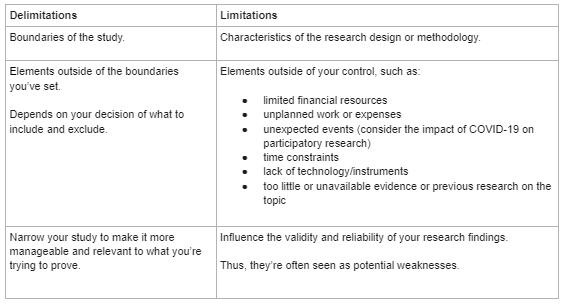
This chart explains the difference between delimitations and limitations. Delimitations are the boundaries of the study while the limitations are the characteristics of the research design or methodology.
Delimitations encompass the elements outside of the boundaries you've set and depends on your decision of what yo include and exclude. On the flip side, limitations are the elements outside of your control, such as:
- limited financial resources
- unplanned work or expenses
- unexpected events (for example, the COVID-19 pandemic)
- time constraints
- lack of technology/instruments
- unavailable evidence or previous research on the topic
Delimitations involve narrowing your study to make it more manageable and relevant to what you're trying to prove. Limitations influence the validity and reliability of your research findings. Limitations are seen as potential weaknesses in your research.
Example of the differences
To clarify these differences, go back to the limitations of the earlier example.
Limitations could comprise:
- Sample size : Not large enough to provide generalizable conclusions.
- Sampling approach : Non-probability sampling has increased bias risk. For instance, the researchers might not manage to capture the experiences of ethnic minority students.
- Methodological pitfalls : Research participants from an urban area (Paris) are likely to be more advantaged than students in rural areas. A study exploring the latter's experiences will probably yield very different findings.
Where do you write the scope and delimitations, and why?
It can be surprisingly empowering to realize you're restricted when conducting scholarly research. But this realization also makes writing up your research easier to grasp and makes it easier to see its limits and the expectations placed on it. Properly revealing this information serves your field and the greater scientific community.
Openly (but briefly) acknowledge the scope and delimitations of your study early on. The Abstract and Introduction sections are good places to set the parameters of your paper.
Next, discuss the scope and delimitations in greater detail in the Methods section. You'll need to do this to justify your methodological approach and data collection instruments, as well as analyses
At this point, spell out why these delimitations were set. What alternative options did you consider? Why did you reject alternatives? What could your study not address?
Let's say you're gathering data that can be derived from different but related experiments. You must convince the reader that the one you selected best suits your research question.
Finally, a solid paper will return to the scope and delimitations in the Findings or Discussion section. Doing so helps readers contextualize and interpret findings because the study's scope and methods influence the results.
For instance, agricultural field experiments carried out under irrigated conditions yield different results from experiments carried out without irrigation.
Being transparent about the scope and any outstanding issues increases your research's credibility and objectivity. It helps other researchers replicate your study and advance scientific understanding of the same topic (e.g., by adopting a different approach).
How do you write the scope and delimitations?
Define the scope and delimitations of your study before collecting data. This is critical. This step should be part of your research project planning.
Answering the following questions will help you address your scope and delimitations clearly and convincingly.
- What are your study's aims and objectives?
- Why did you carry out the study?
- What was the exact topic under investigation?
- Which factors and variables were included? And state why specific variables were omitted from the research scope.
- Who or what did the study explore? What was the target population?
- What was the study's location (geographical area) or setting (e.g., laboratory)?
- What was the timeframe within which you collected your data ?
- Consider a study exploring the differences between identical twins who were raised together versus identical twins who weren't. The data collection might span 5, 10, or more years.
- A study exploring a new immigration policy will cover the period since the policy came into effect and the present moment.
- How was the research conducted (research design)?
- Experimental research, qualitative, quantitative, or mixed-methods research, literature review, etc.
- What data collection tools and analysis techniques were used? e.g., If you chose quantitative methods, which statistical analysis techniques and software did you use?
- What did you find?
- What did you conclude?
Useful vocabulary for scope and delimitations
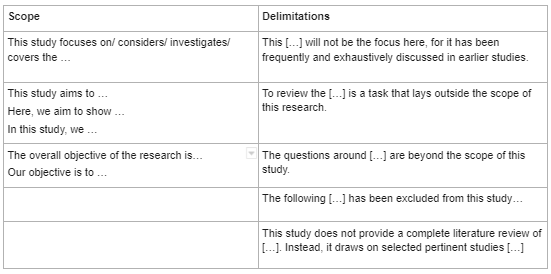
When explaining both the scope and delimitations, it's important to use the proper language to clearly state each.
For the scope , use the following language:
- This study focuses on/considers/investigates/covers the following:
- This study aims to . . . / Here, we aim to show . . . / In this study, we . . .
- The overall objective of the research is . . . / Our objective is to . . .
When stating the delimitations, use the following language:
- This [ . . . ] will not be the focus, for it has been frequently and exhaustively discusses in earlier studies.
- To review the [ . . . ] is a task that lies outside the scope of this study.
- The following [ . . . ] has been excluded from this study . . .
- This study does not provide a complete literature review of [ . . . ]. Instead, it draws on selected pertinent studies [ . . . ]
Analysis of a published scope
In one example, Simione and Gnagnarella (2020) compared the psychological and behavioral impact of COVID-19 on Italy's health workers and general population.
Here's a breakdown of the study's scope into smaller chunks and discussion of what works and why.
Also notable is that this study's delimitations include references to:
- Recruitment of participants: Convenience sampling
- Demographic characteristics of study participants: Age, sex, etc.
- Measurements methods: E.g., the death anxiety scale of the Existential Concerns Questionnaire (ECQ; van Bruggen et al., 2017) etc.
- Data analysis tool: The statistical software R
Analysis of published scope and delimitations
Scope of the study : Johnsson et al. (2019) explored the effect of in-hospital physiotherapy on postoperative physical capacity, physical activity, and lung function in patients who underwent lung cancer surgery.
The delimitations narrowed down the scope as follows:
Refine your scope, delimitations, and scientific English
English ability shouldn't limit how clear and impactful your research can be. Expert AJE editors are available to assess your science and polish your academic writing. See AJE services here .

The AJE Team
See our "Privacy Policy"
Academic Research in Education
- How to Find Books, Articles and eBooks
- Books, eBooks, & Multimedia
- Evaluating Information
- Deciding on a Topic
- Creating a Thesis Statement
- The Literature Review
- Scope of Research
Defining the Scope of your Project
What is scope.
- Choosing a Design
- Citing Sources & Avoiding Plagiarism
- Contact Library
Post-Grad Collective [PGC]. (2017, February 13). Thesis Writing-Narrow the Scope [Video file]. Retrieved from https://www.youtube.com/watch?v=IlCO5yRB9No&feature=youtu.be
Learn to cite a YouTube Video!
The scope of your project sets clear parameters for your research.
A scope statement will give basic information about the depth and breadth of the project. It tells your reader exactly what you want to find out , how you will conduct your study, the reports and deliverables that will be part of the outcome of the study, and the responsibilities of the researchers involved in the study. The extent of the scope will be a part of acknowledging any biases in the research project.
Defining the scope of a project:
- focuses your research goals
- clarifies the expectations for your research project
- helps you determine potential biases in your research methodology by acknowledging the limits of your research study
- identifies the limitations of your research
- << Previous: The Literature Review
- Next: Choosing a Design >>
- Last Updated: Mar 7, 2024 9:06 AM
- URL: https://moc.libguides.com/aca_res_edu

Faculty & Staff Directory
Event Calendar
News Archives
Privacy Policy
Terms & Conditions
Public Relations
634 Henderson St.
Mount Olive, NC 28365
1-800-653-0854
How To Write Scope and Delimitation of a Research Paper (With Examples)

An effective research paper or thesis has a well-written Scope and Delimitation. This portion specifies your study’s coverage and boundaries.
Not yet sure about how to write your research’s Scope and Delimitation? Fret not, as we’ll guide you through the entire writing process through this article.
Related: How To Write Significance of the Study (With Examples)
Table of Contents
What is the scope and delimitation of a research paper.

The “Scope and Delimitation” section states the concepts and variables your study covered. It tells readers which things you have included and excluded in your analysis.
This portion tells two things: 1
- The study’s “Scope” – concepts and variables you have explored in your research and;
- The study’s “Delimitation” – the “boundaries” of your study’s scope. It sets apart the things included in your analysis from those excluded.
For example, your scope might be the effectiveness of plant leaves in lowering blood sugar levels. You can “delimit” your study only to the effect of gabi leaves on the blood glucose of Swiss mice.
Where Should I Put the Scope and Delimitation?
This portion is in Chapter 1, usually after the “Background of the Study.”
Why Should I Write the Scope and Delimitation of My Research Paper?
There’s a lot to discover in a research paper or thesis. However, your resources and time dedicated to it are scarce. Thus, given these constraints, you have to narrow down your study. You do this in the Scope and Delimitation.
Suppose you’re studying the correlation between the quantity of organic fertilizer and plant growth . Experimenting with several types of plants is impossible because of several limitations. So, you’ve decided to use one plant type only.
Informing your readers about this decision is a must. So, you have to state it in your Scope and Delimitation. It also acts as a “disclaimer” that your results are inapplicable to the entire plant kingdom.
What Is the Difference Between Delimitation and Limitation?

People often use the terms “Delimitation” and “Limitation” interchangeably. However, these words differ 2 .
Delimitation refers to factors you set to limit your analysis. It delineates those that are included in your research and those that are excluded. Remember, delimitations are within your control.
Meanwhile, limitations are factors beyond your control that may affect your research’s results. You can think of limitations as the “weaknesses” of your study.
Let’s go back to our previous example. Due to some constraints, you’ve only decided to examine one plant type: dandelions. This is an example of a delimitation since it limits your analysis to dandelions only and not other plant types. Note that the number of plant types used is within your control.
Meanwhile, your study cannot state that a higher quantity of organic fertilizer is the sole reason for plant growth. That’s because your research’s focus is only on correlation. Since this is already beyond your control, then this is a limitation.
How To Write Scope and Delimitation: Step-by-Step Guide
To write your research’s Scope and Delimitation section, follow these steps:
1. Review Your Study’s Objectives and Problem Statement

Your study’s coverage relies on its objectives. Thus, you can only write this section if you know what you’re researching. Furthermore, ensure that you understand the problems you ought to answer.
Once you understand the abovementioned things, you may start writing your study’s Scope and Delimitation.
2. State the Key Information To Explain Your Study’s Coverage and Boundaries

a. The Main Objective of the Research
This refers to the concept that you’re focusing on in your research. Some examples are the following:
- level of awareness or satisfaction of a particular group of people
- correlation between two variables
- effectiveness of a new product
- comparison between two methods/approaches
- lived experiences of several individuals
It’s helpful to consult your study’s Objectives or Statement of the Problem section to determine your research’s primary goal.
b. Independent and Dependent Variables Included
Your study’s independent variable is the variable that you manipulate. Meanwhile, the dependent variable is the variable whose result depends upon the independent variable. Both of these variables must be clear and specific when indicated.
Suppose you study the relationship between social media usage and students’ language skills. These are the possible variables for the study:
- Independent Variable: Number of hours per day spent on using Facebook
- Dependent Variable: Grade 10 students’ scores in Quarterly Examination in English.
Note how specific the variables stated above are. For the independent variable, we narrow it down to Facebook only. Since there are many ways to assess “language skills,” we zero in on the students’ English exam scores as our dependent variable.
c. Subject of the Study
This refers to your study’s respondents or participants.
In our previous example, the research participants are Grade 10 students. However, there are a lot of Grade 10 students in the Philippines. Thus, we have to select from a specific school only—for instance, Grade 10 students from a national high school in Manila.

d. Timeframe and Location of the Study
Specify the month(s), quarter(s), or year(s) as the duration of your study. Also, indicate where you will gather the data required for your research.
e. Brief Description of the Study’s Research Design and Methodology
You may also include whether your research is quantitative or qualitative, the sampling method (cluster, stratified, purposive) applied, and how you conducted the experiment.
Using our previous example, the Grade 10 students can be selected using stratified sampling. Afterward, the researchers may obtain their English quarterly exam scores from their respective teachers. You can add these things to your study’s Scope and Delimitation.
3. Indicate Which Variables or Factors Are Not Covered by Your Research

Although you’ve already set your study’s coverage and boundaries in Step 2, you may also explicitly mention things you’ve excluded from your research.
Returning to our previous example, you can state that your assessment will not include the vocabulary and oral aspects of the English proficiency skill.
Examples of Scope and Delimitation of a Research Paper
1. scope and delimitation examples for quantitative research.

a. Example 1
Research Title
A Study on the Relationship of the Extent of Facebook Usage on the English Proficiency Level of Grade 10 Students of Matagumpay High School
Scope and Delimitation
(Main Objective)
This study assessed the correlation between the respondents’ duration of Facebook usage and their English proficiency level.
(Variables used)
The researchers used the number of hours per day of using Facebook and the activities usually performed on the platform to assess the respondents’ extent of Facebook usage. Meanwhile, the respondents’ English proficiency level is limited to their quarterly English exam scores.
(Subject of the study)
A sample of fifty (50) Grade 10 students of Matagumpay High School served as the study’s respondents.
(Timeframe and location)
This study was conducted during the Second Semester of the School Year 2018 – 2019 on the premises of Matagumpay High School in Metro Manila.
(Methodology)
The respondents are selected by performing stratified random sampling to ensure that there will be ten respondents from five Grade 10 classes of the school mentioned above. The researchers administered a 20-item questionnaire to assess the extent of Facebook usage of the selected respondents. Meanwhile, the data for the respondents’ quarterly exam scores were acquired from their English teachers. The collected data are handled with the utmost confidentiality. Spearman’s Rank Order Correlation was applied to quantitatively assess the correlation between the variables.
(Exclusions)
This study didn’t assess other aspects of the respondents’ English proficiency, such as English vocabulary and oral skills.
Note: The words inside the parentheses in the example above are guides only. They are not included in the actual text.
b. Example 2
Level of Satisfaction of Grade 11 Students on the Implementation of the Online Learning Setup of Matagumpay High School for SY 2020 – 2021
This study aims to identify students’ satisfaction levels with implementing online learning setups during the height of the COVID-19 pandemic.
Students’ satisfaction was assessed according to teachers’ pedagogy, school policies, and learning materials used in the online learning setup. The respondents included sixty (60) Grade 11 students of Matagumpay High School who were randomly picked. The researchers conducted the study from October 2020 to February 2021.
Online platforms such as email and social media applications were used to reach the respondents. The researchers administered a 15-item online questionnaire to measure the respondents’ satisfaction levels. Each response was assessed using a Likert Scale to provide a descriptive interpretation of their answers. A weighted mean was applied to determine the respondents’ general satisfaction.
This study did not cover other factors related to the online learning setup, such as the learning platform used, the schedule of synchronous learning, and channels for information dissemination.
2. Scope and Delimitation Examples for Qualitative Research

Lived Experiences of Public Utility Vehicle (PUV) Drivers of Antipolo City Amidst the Continuous June 2022 Oil Price Hikes
This research focused on the presentation and discussion of the lived experiences of PUV drivers during the constant oil price hike in June 2022.
The respondents involved are five (5) jeepney drivers from Antipolo City who agreed to be interviewed. The researchers assessed their experiences in terms of the following: (1) daily net income; (2) duration and extent of working; (3) alternative employment opportunity considerations; and (4) mental and emotional status. The respondents were interviewed daily at their stations on June 6 – 10, 2022.
In-depth one-on-one interviews were used for data collection. Afterward, the respondents’ first-hand experiences were drafted and annotated with the researchers’ insights.
The researchers excluded some factors in determining the respondents’ experiences, such as physical and health conditions and current family relationship status.
A Study on the Perception of the Residents of Mayamot, Antipolo City on the Political and Socioeconomic Conditions During the Post-EDSA Period (1986 – 1996)
This research aims to discuss the perception of Filipinos regarding the political and socioeconomic economic conditions during the post-EDSA period, specifically during the years 1986 – 1996.
Ten (10) residents of Mayamot, Antipolo City, who belonged to Generation X (currently 40 – 62 years old), were purposively selected as the study’s respondents. The researchers asked them about their perception of the following aspects during the period mentioned above (1) performance of national and local government; (2) bureaucracy and government services; (3) personal economic and financial status; and (4) wage purchasing power.
The researchers conducted face-to-face interviews in the respondents’ residences during the second semester of AY 2018 – 2019. The responses were written and corroborated with the literature on the post-EDSA period.
The following factors were not included in the research analysis: political conflicts and turmoils, the status of the legislative and judicial departments, and other macroeconomic indicators.
Tips and Warnings
1. use the “5ws and 1h” as your guide in understanding your study’s coverage.
- Why did you write your study?
- What variables are included?
- Who are your study’s subject
- Where did you conduct the study?
- When did your study start and end?
- How did you conduct the study?
2. Use key phrases when writing your research’s scope
- This study aims to …
- This study primarily focuses on …
- This study deals with …
- This study will cover …
- This study will be confined…
3. Use key phrases when writing factors beyond your research’s delimitations
- The researcher(s) decided to exclude …
- This study did not cover….
- This study excluded …
- These variables/factors were excluded from the study…
4. Don’t forget to ask for help
Your research adviser can assist you in selecting specific concepts and variables suitable to your study. Make sure to consult him/her regularly.
5. Make it brief
No need to make this section wordy. You’re good to go if you meet the “5Ws and 1Hs”.
Frequently Asked Questions
1. what are scope and delimitation in tagalog.
In a Filipino research ( pananaliksik ), Scope and Delimitation is called “ Saklaw at Delimitasyon”.
Here’s an example of Scope and Delimitation in Filipino:
Pamagat ng Pananaliksik
Epekto Ng Paggamit Ng Mga Digital Learning Tools Sa Pag-Aaral Ng Mga Mag-Aaral Ng Mataas Na Paaralan Ng Matagumpay Sa General Mathematics
Sakop at Delimitasyon ng Pag-aaral
Nakatuon ang pananaliksik na ito sa epekto ng paggamit ng mga digital learning aids sa pag-aaral ng mga mag-aaral.
Ang mga digital learning tools na kinonsidera sa pag-aaral na ito ay Google Classroom, Edmodo, Kahoot, at mga piling bidyo mula YouTube. Samantala, ang epekto sa pag-aaral ng mga mag-aaral ng mga nabanggit na digital learning tools ay natukoy sa pamamagitan ng kanilang (1) mga pananaw hinggil sa benepisyo nito sa kanilang pag-aaral sa General Mathematics at (2) kanilang average grade sa asignaturang ito.
Dalawampu’t-limang (25) mag-aaral mula sa Senior High School ng Mataas na Paaralan ng Matagumpay ang pinili para sa pananaliksik na ito. Sila ay na-interbyu at binigyan ng questionnaire noong Enero 2022 sa nasabing paaralan. Sinuri ang resulta ng pananaliksik sa pamamagitan ng mga instrumentong estadistikal na weighted mean at Analysis of Variance (ANOVA). Hindi saklaw ng pananaliksik na ito ang ibang mga aspeto hinggil sa epekto ng online learning aids sa pag-aaral gaya ng lebel ng pag-unawa sa aralin at kakayahang iugnay ito sa araw-araw na buhay.
2. The Scope and Delimitation should consist of how many paragraphs?
Three or more paragraphs will suffice for your study’s Scope and Delimitation. Here’s our suggestion on what you should write for each paragraph:
Paragraph 1: Introduction (state research objective) Paragraph 2: Coverage and boundaries of the research (you may divide this section into 2-3 paragraphs) Paragraph 3 : Factors excluded from the study
- University of St. La Salle. Unit 3: Lesson 3 Setting the Scope and Limitation of a Qualitative Research [Ebook] (p. 12). Retrieved from https://www.studocu.com/ph/document/university-of-st-la-salle/senior-high-school/final-sg-pr1-11-12-unit-3-lesson-3-setting-the-scope-and-limitation-of-a-qualitative-research/24341582
- Theofanidis, D., & Fountouki, A. (2018). Limitations and Delimitations in the Research Process. Perioperative Nursing (GORNA), 7(3), 155–162. doi: 10.5281/zenodo.2552022
Written by Jewel Kyle Fabula
in Career and Education , Juander How
Jewel Kyle Fabula
Jewel Kyle Fabula is a Bachelor of Science in Economics student at the University of the Philippines Diliman. His passion for learning mathematics developed as he competed in some mathematics competitions during his Junior High School years. He loves cats, playing video games, and listening to music.
Browse all articles written by Jewel Kyle Fabula
Copyright Notice
All materials contained on this site are protected by the Republic of the Philippines copyright law and may not be reproduced, distributed, transmitted, displayed, published, or broadcast without the prior written permission of filipiknow.net or in the case of third party materials, the owner of that content. You may not alter or remove any trademark, copyright, or other notice from copies of the content. Be warned that we have already reported and helped terminate several websites and YouTube channels for blatantly stealing our content. If you wish to use filipiknow.net content for commercial purposes, such as for content syndication, etc., please contact us at legal(at)filipiknow(dot)net

Setting Limits and Focusing Your Study: Exploring scope and delimitation
As a researcher, it can be easy to get lost in the vast expanse of information and data available. Thus, when starting a research project, one of the most important things to consider is the scope and delimitation of the study. Setting limits and focusing your study is essential to ensure that the research project is manageable, relevant, and able to produce useful results. In this article, we will explore the importance of setting limits and focusing your study through an in-depth analysis of scope and delimitation.
Company Name 123
Lorem ipsum dolor sit amet, cu usu cibo vituperata, id ius probo maiestatis inciderint, sit eu vide volutpat.
Sign Up for More Insights
Table of Contents
Scope and Delimitation – Definition and difference
Scope refers to the range of the research project and the study limitations set in place to define the boundaries of the project and delimitation refers to the specific aspects of the research project that the study will focus on.
In simpler words, scope is the breadth of your study, while delimitation is the depth of your study.
Scope and delimitation are both essential components of a research project, and they are often confused with one another. The scope defines the parameters of the study, while delimitation sets the boundaries within those parameters. The scope and delimitation of a study are usually established early on in the research process and guide the rest of the project.
Types of Scope and Delimitation
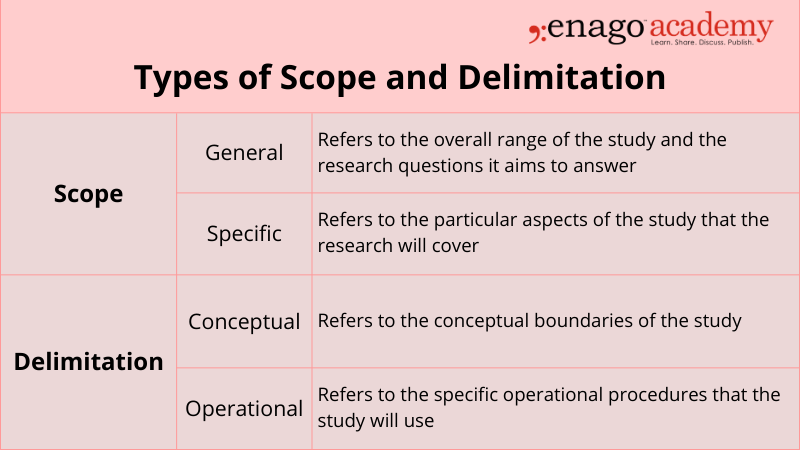
Significance of Scope and Delimitation
Setting limits and focusing your study through scope and delimitation is crucial for the following reasons:
- It allows researchers to define the research project’s boundaries, enabling them to focus on specific aspects of the project. This focus makes it easier to gather relevant data and avoid unnecessary information that might complicate the study’s results.
- Setting limits and focusing your study through scope and delimitation enables the researcher to stay within the parameters of the project’s resources.
- A well-defined scope and delimitation ensure that the research project can be completed within the available resources, such as time and budget, while still achieving the project’s objectives.
5 Steps to Setting Limits and Defining the Scope and Delimitation of Your Study

There are a few steps that you can take to set limits and focus your study.
1. Identify your research question or topic
The first step is to identify what you are interested in learning about. The research question should be specific, measurable, achievable, relevant, and time-bound (SMART). Once you have a research question or topic, you can start to narrow your focus.
2. Consider the key terms or concepts related to your topic
What are the important terms or concepts that you need to understand in order to answer your research question? Consider all available resources, such as time, budget, and data availability, when setting scope and delimitation.
The scope and delimitation should be established within the parameters of the available resources. Once you have identified the key terms or concepts, you can start to develop a glossary or list of definitions.
3. Consider the different perspectives on your topic
There are often different perspectives on any given topic. Get feedback on the proposed scope and delimitation. Advisors can provide guidance on the feasibility of the study and offer suggestions for improvement.
It is important to consider all of the different perspectives in order to get a well-rounded understanding of your topic.
4. Narrow your focus
Be specific and concise when setting scope and delimitation. The parameters of the study should be clearly defined to avoid ambiguity and ensure that the study is focused on relevant aspects of the research question.
This means deciding which aspects of your topic you will focus on and which aspects you will eliminate.
5. Develop the final research plan
Revisit and revise the scope and delimitation as needed. As the research project progresses, the scope and delimitation may need to be adjusted to ensure that the study remains focused on the research question and can produce useful results. This plan should include your research goals, methods, and timeline.
Examples of Scope and Delimitation
To better understand scope and delimitation, let us consider two examples of research questions and how scope and delimitation would apply to them.
Research question: What are the effects of social media on mental health?
Scope: The scope of the study will focus on the impact of social media on the mental health of young adults aged 18-24 in the United States.
Delimitation: The study will specifically examine the following aspects of social media: frequency of use, types of social media platforms used, and the impact of social media on self-esteem and body image.
Research question: What are the factors that influence employee job satisfaction in the healthcare industry?
Scope: The scope of the study will focus on employee job satisfaction in the healthcare industry in the United States.
Delimitation: The study will specifically examine the following factors that influence employee job satisfaction: salary, work-life balance, job security, and opportunities for career growth.
Setting limits and defining the scope and delimitation of a research study is essential to conducting effective research. By doing so, researchers can ensure that their study is focused, manageable, and feasible within the given time frame and resources. It can also help to identify areas that require further study, providing a foundation for future research.
So, the next time you embark on a research project, don’t forget to set clear limits and define the scope and delimitation of your study. It may seem like a tedious task, but it can ultimately lead to more meaningful and impactful research. And if you still can’t find a solution, reach out to Enago Academy using #AskEnago and tag @EnagoAcademy on Twitter , Facebook , and Quora .
Frequently Asked Questions
The scope in research refers to the boundaries and extent of a study, defining its specific objectives, target population, variables, methods, and limitations, which helps researchers focus and provide a clear understanding of what will be investigated.
Delimitation in research defines the specific boundaries and limitations of a study, such as geographical, temporal, or conceptual constraints, outlining what will be excluded or not within the scope of investigation, providing clarity and ensuring the study remains focused and manageable.
To write a scope; 1. Clearly define research objectives. 2. Identify specific research questions. 3. Determine the target population for the study. 4. Outline the variables to be investigated. 5. Establish limitations and constraints. 6. Set boundaries and extent of the investigation. 7. Ensure focus, clarity, and manageability. 8. Provide context for the research project.
To write delimitations; 1. Identify geographical boundaries or constraints. 2. Define the specific time period or timeframe of the study. 3. Specify the sample size or selection criteria. 4. Clarify any demographic limitations (e.g., age, gender, occupation). 5. Address any limitations related to data collection methods. 6. Consider limitations regarding the availability of resources or data. 7. Exclude specific variables or factors from the scope of the study. 8. Clearly state any conceptual boundaries or theoretical frameworks. 9. Acknowledge any potential biases or constraints in the research design. 10. Ensure that the delimitations provide a clear focus and scope for the study.
What is an example of delimitation of the study?
Thank you 💕
Thank You very simplified🩷
Thanks, I find this article very helpful
Rate this article Cancel Reply
Your email address will not be published.

Enago Academy's Most Popular Articles

- Publishing Research
- Reporting Research
How to Optimize Your Research Process: A step-by-step guide
For researchers across disciplines, the path to uncovering novel findings and insights is often filled…

- Industry News
- Trending Now
Breaking Barriers: Sony and Nature unveil “Women in Technology Award”
Sony Group Corporation and the prestigious scientific journal Nature have collaborated to launch the inaugural…

Achieving Research Excellence: Checklist for good research practices
Academia is built on the foundation of trustworthy and high-quality research, supported by the pillars…

- Promoting Research
Plain Language Summary — Communicating your research to bridge the academic-lay gap
Science can be complex, but does that mean it should not be accessible to the…

Science under Surveillance: Journals adopt advanced AI to uncover image manipulation
Journals are increasingly turning to cutting-edge AI tools to uncover deceitful images published in manuscripts.…
Choosing the Right Analytical Approach: Thematic analysis vs. content analysis for…
Research Recommendations – Guiding policy-makers for evidence-based decision making
Demystifying the Role of Confounding Variables in Research

Sign-up to read more
Subscribe for free to get unrestricted access to all our resources on research writing and academic publishing including:
- 2000+ blog articles
- 50+ Webinars
- 10+ Expert podcasts
- 50+ Infographics
- 10+ Checklists
- Research Guides
We hate spam too. We promise to protect your privacy and never spam you.
I am looking for Editing/ Proofreading services for my manuscript Tentative date of next journal submission:

As a researcher, what do you consider most when choosing an image manipulation detector?
- USC Libraries
- Research Guides
Organizing Your Social Sciences Research Paper
- Choosing a Title
- Purpose of Guide
- Design Flaws to Avoid
- Independent and Dependent Variables
- Glossary of Research Terms
- Reading Research Effectively
- Narrowing a Topic Idea
- Broadening a Topic Idea
- Extending the Timeliness of a Topic Idea
- Academic Writing Style
- Applying Critical Thinking
- Making an Outline
- Paragraph Development
- Research Process Video Series
- Executive Summary
- The C.A.R.S. Model
- Background Information
- The Research Problem/Question
- Theoretical Framework
- Citation Tracking
- Content Alert Services
- Evaluating Sources
- Primary Sources
- Secondary Sources
- Tiertiary Sources
- Scholarly vs. Popular Publications
- Qualitative Methods
- Quantitative Methods
- Insiderness
- Using Non-Textual Elements
- Limitations of the Study
- Common Grammar Mistakes
- Writing Concisely
- Avoiding Plagiarism
- Footnotes or Endnotes?
- Further Readings
- Generative AI and Writing
- USC Libraries Tutorials and Other Guides
- Bibliography
The title summarizes the main idea or ideas of your study. A good title contains the fewest possible words needed to adequately describe the content and/or purpose of your research paper.
Importance of Choosing a Good Title
The title is the part of a paper that is read the most, and it is usually read first . It is, therefore, the most important element that defines the research study. With this in mind, avoid the following when creating a title:
- If the title is too long, this usually indicates there are too many unnecessary words. Avoid language, such as, "A Study to Investigate the...," or "An Examination of the...." These phrases are obvious and generally superfluous unless they are necessary to covey the scope, intent, or type of a study.
- On the other hand, a title which is too short often uses words which are too broad and, thus, does not tell the reader what is being studied. For example, a paper with the title, "African Politics" is so non-specific the title could be the title of a book and so ambiguous that it could refer to anything associated with politics in Africa. A good title should provide information about the focus and/or scope of your research study.
- In academic writing, catchy phrases or non-specific language may be used, but only if it's within the context of the study [e.g., "Fair and Impartial Jury--Catch as Catch Can"]. However, in most cases, you should avoid including words or phrases that do not help the reader understand the purpose of your paper.
- Academic writing is a serious and deliberate endeavor. Avoid using humorous or clever journalistic styles of phrasing when creating the title to your paper. Journalistic headlines often use emotional adjectives [e.g., incredible, amazing, effortless] to highlight a problem experienced by the reader or use "trigger words" or interrogative words like how, what, when, or why to persuade people to read the article or click on a link. These approaches are viewed as counter-productive in academic writing. A reader does not need clever or humorous titles to catch their attention because the act of reading research is assumed to be deliberate based on a desire to learn and improve understanding of the problem. In addition, a humorous title can merely detract from the seriousness and authority of your research.
- Unlike everywhere else in a college-level social sciences research paper [except when using direct quotes in the text], titles do not have to adhere to rigid grammatical or stylistic standards. For example, it could be appropriate to begin a title with a coordinating conjunction [i.e., and, but, or, nor, for, so, yet] if it makes sense to do so and does not detract from the purpose of the study [e.g., "Yet Another Look at Mutual Fund Tournaments"] or beginning the title with an inflected form of a verb such as those ending in -ing [e.g., "Assessing the Political Landscape: Structure, Cognition, and Power in Organizations"].
Appiah, Kingsley Richard et al. “Structural Organisation of Research Article Titles: A Comparative Study of Titles of Business, Gynaecology and Law.” Advances in Language and Literary Studies 10 (2019); Hartley James. “To Attract or to Inform: What are Titles for?” Journal of Technical Writing and Communication 35 (2005): 203-213; Jaakkola, Maarit. “Journalistic Writing and Style.” In Oxford Research Encyclopedia of Communication . Jon F. Nussbaum, editor. (New York: Oxford University Press, 2018): https://oxfordre.com/communication.
Structure and Writing Style
The following parameters can be used to help you formulate a suitable research paper title:
- The purpose of the research
- The scope of the research
- The narrative tone of the paper [typically defined by the type of the research]
- The methods used to study the problem
The initial aim of a title is to capture the reader’s attention and to highlight the research problem under investigation.
Create a Working Title Typically, the final title you submit to your professor is created after the research is complete so that the title accurately captures what has been done . The working title should be developed early in the research process because it can help anchor the focus of the study in much the same way the research problem does. Referring back to the working title can help you reorient yourself back to the main purpose of the study if you find yourself drifting off on a tangent while writing. The Final Title Effective titles in research papers have several characteristics that reflect general principles of academic writing.
- Indicate accurately the subject and scope of the study,
- Rarely use abbreviations or acronyms unless they are commonly known,
- Use words that create a positive impression and stimulate reader interest,
- Use current nomenclature from the field of study,
- Identify key variables, both dependent and independent,
- Reveal how the paper will be organized,
- Suggest a relationship between variables which supports the major hypothesis,
- Is limited to 5 to 15 substantive words,
- Does not include redundant phrasing, such as, "A Study of," "An Analysis of" or similar constructions,
- Takes the form of a question or declarative statement,
- If you use a quote as part of the title, the source of the quote is cited [usually using an asterisk and footnote],
- Use correct grammar and capitalization with all first words and last words capitalized, including the first word of a subtitle. All nouns, pronouns, verbs, adjectives, and adverbs that appear between the first and last words of the title are also capitalized, and
- Rarely uses an exclamation mark at the end of the title.
The Subtitle Subtitles are frequently used in social sciences research papers because it helps the reader understand the scope of the study in relation to how it was designed to address the research problem. Think about what type of subtitle listed below reflects the overall approach to your study and whether you believe a subtitle is needed to emphasize the investigative parameters of your research.
1. Explains or provides additional context , e.g., "Linguistic Ethnography and the Study of Welfare Institutions as a Flow of Social Practices: The Case of Residential Child Care Institutions as Paradoxical Institutions." [Palomares, Manuel and David Poveda. Text & Talk: An Interdisciplinary Journal of Language, Discourse and Communication Studies 30 (January 2010): 193-212]
2. Adds substance to a literary, provocative, or imaginative title or quote , e.g., "Listen to What I Say, Not How I Vote": Congressional Support for the President in Washington and at Home." [Grose, Christian R. and Keesha M. Middlemass. Social Science Quarterly 91 (March 2010): 143-167]
3. Qualifies the geographic scope of the research , e.g., "The Geopolitics of the Eastern Border of the European Union: The Case of Romania-Moldova-Ukraine." [Marcu, Silvia. Geopolitics 14 (August 2009): 409-432]
4. Qualifies the temporal scope of the research , e.g., "A Comparison of the Progressive Era and the Depression Years: Societal Influences on Predictions of the Future of the Library, 1895-1940." [Grossman, Hal B. Libraries & the Cultural Record 46 (2011): 102-128]
5. Focuses on investigating the ideas, theories, or work of a particular individual , e.g., "A Deliberative Conception of Politics: How Francesco Saverio Merlino Related Anarchy and Democracy." [La Torre, Massimo. Sociologia del Diritto 28 (January 2001): 75 - 98]
6. Identifies the methodology used , e.g. "Student Activism of the 1960s Revisited: A Multivariate Analysis Research Note." [Aron, William S. Social Forces 52 (March 1974): 408-414]
7. Defines the overarching technique for analyzing the research problem , e.g., "Explaining Territorial Change in Federal Democracies: A Comparative Historical Institutionalist Approach." [ Tillin, Louise. Political Studies 63 (August 2015): 626-641.
With these examples in mind, think about what type of subtitle reflects the overall approach to your study. This will help the reader understand the scope of the study in relation to how it was designed to address the research problem.
Anstey, A. “Writing Style: What's in a Title?” British Journal of Dermatology 170 (May 2014): 1003-1004; Balch, Tucker. How to Compose a Title for Your Research Paper. Augmented Trader blog. School of Interactive Computing, Georgia Tech University; Bavdekar, Sandeep B. “Formulating the Right Title for a Research Article.” Journal of Association of Physicians of India 64 (February 2016); Choosing the Proper Research Paper Titles. AplusReports.com, 2007-2012; Eva, Kevin W. “Titles, Abstracts, and Authors.” In How to Write a Paper . George M. Hall, editor. 5th edition. (Oxford: John Wiley and Sons, 2013), pp. 33-41; Hartley James. “To Attract or to Inform: What are Titles for?” Journal of Technical Writing and Communication 35 (2005): 203-213; General Format. The Writing Lab and The OWL. Purdue University; Kerkut G.A. “Choosing a Title for a Paper.” Comparative Biochemistry and Physiology Part A: Physiology 74 (1983): 1; “Tempting Titles.” In Stylish Academic Writing . Helen Sword, editor. (Cambridge, MA: Harvard University Press, 2012), pp. 63-75; Nundy, Samiran, et al. “How to Choose a Title?” In How to Practice Academic Medicine and Publish from Developing Countries? A Practical Guide . Edited by Samiran Nundy, Atul Kakar, and Zulfiqar A. Bhutta. (Springer Singapore, 2022), pp. 185-192.
- << Previous: Applying Critical Thinking
- Next: Making an Outline >>
- Last Updated: May 9, 2024 11:05 AM
- URL: https://libguides.usc.edu/writingguide
Identifying Barriers and Facilitators to Accessing Care for Historically Marginalized Communities Affected by Parkinson Disease: A Qualitative Study
- Published: 08 May 2024
Cite this article

- Danielle Kipnis 1 ,
- Michele Lin 1 ,
- Alissa Pacheco 1 ,
- Nia Mensah 1 , 5 , 6 ,
- Chelsea E. Macpherson 1 ,
- Kelsey Kempner 1 ,
- Anita Parker 3 ,
- R. Bernard Coley 4 ,
- Denise Coley 4 ,
- Hiral Shah 2 &
- Lori Quinn ORCID: orcid.org/0000-0002-2982-923X 1
36 Accesses
Explore all metrics
Introduction
Parkinson disease (PD) is the second most common neurodegenerative disease. Members of the Black Diaspora (MBD) and Hispanic/Latinx people are less likely to receive a timely diagnosis following the onset of symptoms and more likely to experience greater disease severity due to late diagnosis. Historically marginalized populations (i.e., MBD, Hispanic, and Latinx communities) are not accurately represented in research; this, along with many other barriers, compounds underreporting and lack of recognition of PD. It is important to understand barriers to early diagnosis and healthcare access for these historically marginalized populations from the community’s perspective.
Our team conducted two focus groups to identify barriers and facilitators to PD healthcare-seeking behavior. We sought to identify which barriers are modifiable to ultimately improve engagement in neurological care for MBD and Hispanic individuals affected by PD.
We enrolled 15 participants (13 female; African/African American/Black n = 10, Hispanic/Puerto Rican n = 3, other n = 2) for two focus groups. Discussions revealed sources of barriers to healthcare-seeking behavior in three main domains: legacy of racism in the United States, ancestral cultural environment, and healthcare system access. These sources influenced individuals’ PD knowledge and familiarity. Additionally, participants expressed a desire to know more about PD and called for increased community-based programming for education and awareness.
This paper uses a community-based participatory research approach to describe the experiences of MBD, Hispanic, and Latinx people in Manhattan and the surrounding areas in relation to possible sources of healthcare disparities and delayed PD diagnosis. These sources have broad implications and should be addressed through collaborative community programming.
This is a preview of subscription content, log in via an institution to check access.
Access this article
Price includes VAT (Russian Federation)
Instant access to the full article PDF.
Rent this article via DeepDyve
Institutional subscriptions
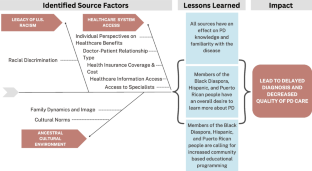
Similar content being viewed by others
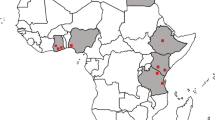
Transforming Parkinson's Care in Africa (TraPCAf): protocol for a multimethodology National Institute for Health and Care Research Global Health Research Group project

The lived experience of stigma and parkinson’s disease in Kenya: a public health challenge
Palliative care for persons with parkinson’s disease: a qualitative study on the experiences of health care professionals, data availability.
De-identified data is available upon request to the authors.
Code Availability
Not applicable.
This term was decided on with our community partners. It is defined as the collection of individuals without regard to actual ethnicity or country of origin who share in the US Black experience, treatment, or targeting which results in inequitable or disparate treatment from the perceived normal treatment or experience.
When referring to the specific participants in our study, we will use this term to best reflect that participants in our study identified as Hispanic and Puerto Rican. We will use the term Hispanic or Latinx when referring to the population generally or to prior research reporting on those ethnicities.
LaHue SC, Comella CL, Tanner CM. The best medicine? The influence of physical activity and inactivity on Parkinson’s disease. Mov Disord. 2016;31:1444–54. https://doi.org/10.1002/mds.26728 .
Article PubMed PubMed Central Google Scholar
Wright Willis A, Evanoff BA, Lian M, Criswell SR, Racette BA. Geographic and ethnic variation in Parkinson disease: a population-based study of US Medicare beneficiaries. Neuroepidemiology. 2010;34:143–51. https://doi.org/10.1159/000275491 .
Dahodwala N, Karlawish J, Siderowf A, Duda JE, Mandell DS. Delayed Parkinson’s disease diagnosis among African-Americans: the role of reporting of disability. Neuroepidemiology. 2011;36:150–4. https://doi.org/10.1159/000324935 .
Ben-Joseph A, Marshall CR, Lees AJ, Noyce AJ. Ethnic variation in the manifestation of Parkinson’s disease: a narrative review. JPD. 2020;10:31–45. https://doi.org/10.3233/JPD-191763 .
Article PubMed Google Scholar
Cheng EM, Siderowf AD, Swarztrauber K, Lee M, Vassar S, Jacob E, Eisa MS, Vickrey BG. Disparities of care in veterans with Parkinson’s disease. Parkinsonism Relat Disord. 2008;14:8–14. https://doi.org/10.1016/j.parkreldis.2007.05.001 .
Article CAS PubMed Google Scholar
Rhee TG, Marottoli RA, Van Ness PH, Levy BR. Impact of perceived racism on healthcare access among older minority adults. Am J Prev Med. 2019;56:580–5. https://doi.org/10.1016/j.amepre.2018.10.010 .
Turner BE, Steinberg JR, Weeks BT, Rodriguez F, Cullen MR. Race/ethnicity reporting and representation in US clinical trials: a cohort study. Lancet Reg Health - Am. 2022;11:100252. https://doi.org/10.1016/j.lana.2022.100252 .
Kipnis D, Pacheco A, Delfing D, Toomer-Mensah N, Macpherson CE, Rieger J, Parker A, Coley RB, Coley D, Shah H, Quinn L. Community-based participatory research approach to address healthcare disparities confronting members of the Black Diaspora with Parkinson’s disease. Parkinsonism Relat Disord. 2024;119:105936. https://doi.org/10.1016/j.parkreldis.2023.105936 .
Heffernan ME, Barrera L, Guzman ZR, Golbeck E, Jedraszko AM, Hays PT, Herzog KA, D’Aquila RT, Ison MG, McColley SA. Barriers and facilitators to recruitment of underrepresented research participants: perspectives of clinical research coordinators. J Clin Trans Sci. 2023;7:e193. https://doi.org/10.1017/cts.2023.611 .
Article Google Scholar
Nuytemans K, Manrique CP, Uhlenberg A, Scott WK, Cuccaro ML, Luca CC, Singer C, Vance JM. Motivations for participation in Parkinson disease genetic research among Hispanics versus non-Hispanics. Front Genet. 2019;10:658. https://doi.org/10.3389/fgene.2019.00658 .
Saadi A, Himmelstein DU, Woolhandler S, Mejia NI. Racial disparities in neurologic health care access and utilization in the United States. Neurology. 2017;88:2268–75. https://doi.org/10.1212/WNL.0000000000004025 .
Berkman ND, Sheridan SL, Donahue KE, Halpern DJ, Crotty K. Low health literacy and health outcomes: an updated systematic review. Ann Intern Med. 2011;155:97. https://doi.org/10.7326/0003-4819-155-2-201107190-00005 .
Kim R, Kim H-J, Jeon B. The good, the bad, and the ugly of medical information on the Internet. Mov Disord. 2018;33:754–7. https://doi.org/10.1002/mds.27324 .
Fitzsimmons P, Michael B, Hulley J, Scott G. A readability assessment of online Parkinson’s disease information. JRCPE. 2010;40:292–6. https://doi.org/10.4997/JRCPE.2010.401 .
Article CAS Google Scholar
Chapman EN, Kaatz A, Carnes M. Physicians and implicit bias: how doctors may unwittingly perpetuate health care disparities. J Gen Intern Med. 2013;28:1504–10. https://doi.org/10.1007/s11606-013-2441-1 .
Hall WJ, Chapman MV, Lee KM, Merino YM, Thomas TW, Payne BK, Eng E, Day SH, Coyne-Beasley T. Implicit racial/ethnic bias among health care professionals and its influence on health care outcomes: a systematic review. Am J Public Health. 2015;105:e60–76. https://doi.org/10.2105/AJPH.2015.302903 .
Dahodwala N, Xie M, Noll E, Siderowf A, Mandell DS. Treatment disparities in Parkinson’s disease. Ann Neurol. 2009;66:142–5. https://doi.org/10.1002/ana.21774 .
Pan S, Stutzbach J, Reichwein S, Lee BK, Dahodwala N. Knowledge and attitudes about Parkinson’s disease among a diverse group of older adults. J Cross Cult Gerontol. 2014;29:339–52. https://doi.org/10.1007/s10823-014-9233-x .
Xia R, Stone JR, Hoffman JE, Klappa SG. Promoting community health and eliminating health disparities through community-based participatory research. Phys Ther. 2016;96:410–7. https://doi.org/10.2522/ptj.20140529 .
Neubauer BE, Witkop CT, Varpio L. How phenomenology can help us learn from the experiences of others, Perspect. Med Educ. 2019;8:90–7. https://doi.org/10.1007/s40037-019-0509-2 .
Betancourt JR, Green AR, Carrillo JE, Ananeh-Firempong O. Defining cultural competence: a practical framework for addressing racial/ethnic disparities in health and health care. Public Health Rep. 2003;118:293–302. https://doi.org/10.1016/S0033-3549(04)50253-4 .
Yacoubian TA, Howard G, Kissela B, Sands CD, Standaert DG. Racial differences in Parkinson’s disease medication use in the reasons for geographic and racial differences in stroke cohort: a cross-sectional study. Neuroepidemiology. 2009;33:329–34. https://doi.org/10.1159/000254568 .
Social Determinants of Health - Healthy People 2030 health.gov. 2023. https://health.gov/healthypeople/priority-areas/social-determinants-health . Accessed 22 Jun 2023.
Canizares M, Gignac M, Hogg-Johnson S, Glazier RH, Badley EM. Do baby boomers use more healthcare services than other generations? Longitudinal trajectories of physician service use across five birth cohorts. BMJ Open. 2016;6:e013276. https://doi.org/10.1136/bmjopen-2016-013276 .
Lopez De Coca T, Moreno L, Alacreu M, Sebastian-Morello M. Bridging the generational digital divide in the healthcare environment. JPM. 2022;12:1214. https://doi.org/10.3390/jpm12081214 .
Ferdinand KC. Novel interventions in addressing racial disparities in blood pressure control: potential utilization of barbershops in Black men. Circulation. 2018;138:339–41. https://doi.org/10.1161/CIRCULATIONAHA.118.034869 .
Campbell MK, Hudson MA, Resnicow K, Blakeney N, Paxton A, Baskin M. Church-based health promotion interventions: evidence and lessons learned. Annu Rev Public Health. 2007;28:213–34. https://doi.org/10.1146/annurev.publhealth.28.021406.144016 .
Bernard Coley R, Coley D. Utilizing a variation of the train the trainer model to create best practice guidelines and to build a culturally sensitive and community educated team of ambassadors to increase diverse enrollment in clinical trial research studies. Barcelona, Spain: World Parkinson Congress; 2023;.
Download references
Acknowledgements
We would like to acknowledge Ms. Norma Husband, RN, who was a partner in our community-based participatory research project from 2018 to 2021. We would also like to acknowledge Elizabeth Delaney, MSW, LCSW, and Dr. Glenn Stebbins [GS], PhD, for their consultation throughout this project and Ashrita Satchida, MA, for her contributions to the literature review.
This publication was supported by the National Center for Advancing Translational Sciences, National Institutes of Health, through Grant Number UL1TR001873.
Author information
Authors and affiliations.
Department of Biobehavioral Sciences, Teachers College, Columbia University, New York, USA
Danielle Kipnis, Michele Lin, Alissa Pacheco, Nia Mensah, Yu Gu, Chelsea E. Macpherson, Kelsey Kempner & Lori Quinn
Department of Neurology, Columbia University Irving Medical Center, New York, USA
St. Luke A.M.E. Church, New York, USA
Anita Parker
SIG-Black Diaspora, Morgan Hill, CA, USA
R. Bernard Coley & Denise Coley
Long Island University, Brooklyn, NY, USA
Kusudi International, New York, USA
You can also search for this author in PubMed Google Scholar
Contributions
Research project: A. conception, B. organization, C. execution.
Statistical analysis: A. design, B. execution, C. review and critique
Manuscript preparation: A. writing of the first draft, B. review and critique
Danielle Kipnis: 1A, 1B, 1C, 2A, 2B, 2C, 3A, 3B
Michele Lin: 2A, 2B, 2C, 3A, 3B
Alissa Pacheco: 1A, 1B, 1C, 2C, 3B
Nia Mensah: 1A, 1B, 2C, 3B
Yu Gu: 1A, 1B, 1C, 2C, 3B
Chelsea Macpherson: 1A, 1B, 2C, 3B
Kelsey Kempner: 3A, 3B
Bernard Coley: 2C, 3B
Denise Coley: 2C, 3B
Anita Parker: 1A, 1B, 1C, 2C, 3B
Hiral Shah: 1A, 1B, 1C, 2A, 2C, 3B
Lori Quinn: 1A, 1B, 1C, 2A, 2C, 3B
Corresponding author
Correspondence to Lori Quinn .
Ethics declarations
Ethics approval.
We obtained ethical approval to conduct research from the Teachers College and Columbia University Institutional Review Boards (IRB # 21–265 and IRB-AAAT5742).
Consent to Participate
Informed consent was obtained from all participants to participate in the study.
Consent for Publication
Consent for publication was obtained from all participants in the signed informed consent document.
Competing Interests
The authors declare no competing to disclose.
The content is solely the responsibility of the authors and does not necessarily represent the official views of the NIH.
Additional information
Publisher's note.
Springer Nature remains neutral with regard to jurisdictional claims in published maps and institutional affiliations.
Rights and permissions
Springer Nature or its licensor (e.g. a society or other partner) holds exclusive rights to this article under a publishing agreement with the author(s) or other rightsholder(s); author self-archiving of the accepted manuscript version of this article is solely governed by the terms of such publishing agreement and applicable law.
Reprints and permissions
About this article
Kipnis, D., Lin, M., Pacheco, A. et al. Identifying Barriers and Facilitators to Accessing Care for Historically Marginalized Communities Affected by Parkinson Disease: A Qualitative Study. J. Racial and Ethnic Health Disparities (2024). https://doi.org/10.1007/s40615-024-02011-2
Download citation
Received : 18 October 2023
Revised : 07 April 2024
Accepted : 18 April 2024
Published : 08 May 2024
DOI : https://doi.org/10.1007/s40615-024-02011-2
Share this article
Anyone you share the following link with will be able to read this content:
Sorry, a shareable link is not currently available for this article.
Provided by the Springer Nature SharedIt content-sharing initiative
- Parkinson disease
- Healthcare disparities
- Community-based participatory research
- Members of the Black Diaspora
- Hispanic people
- Puerto Rican people
- Qualitative research
- Find a journal
- Publish with us
- Track your research

IMAGES
VIDEO
COMMENTS
Scope of research refers to the range of topics, areas, and subjects that a research project intends to cover. It is the extent and limitations of the study, defining what is included and excluded in the research. The scope of a research project depends on various factors, such as the research questions, objectives, methodology, and available ...
How to Write the Scope of the Study. Take home message. The scope of the study is defined at the start of the research project before data collection begins. It is used by researchers to set the boundaries and limitations within which the study will be performed. In this post you will learn exactly what the scope of the study means, why it is ...
Scope of research is determined at the beginning of your research process, prior to the data collection stage. Sometimes called "scope of study," your scope delineates what will and will not be covered in your project. It helps you focus your work and your time, ensuring that you'll be able to achieve your goals and outcomes.
The scope and delimitations of a thesis, dissertation or research paper define the topic and boundaries of the research problem to be investigated. The scope details how in-depth your study is to explore the research question and the parameters in which it will operate in relation to the population and timeframe.
What is the scope in a research paper? Simply put, the scope is the domain of your research. It describes the extent to which the research question will be explored in your study. Articulating your study's scope early on helps you make your research question focused and realistic.
The scope of your project sets clear parameters for your research. A scope statement will give basic information about the depth and breadth of the project. It tells your reader exactly what you want to find out, how you will conduct your study, the reports and deliverables that will be part of the outcome of the study, and the responsibilities ...
What is scope and delimitation in research. The scope of a research paper explains the context and framework for the study, outlines the extent, variables, or dimensions that will be investigated, and provides details of the parameters within which the study is conducted.Delimitations in research, on the other hand, refer to the limitations imposed on the study.
Answer: The scope of a study explains the extent to which the research area will be explored in your work, and it specifies the parameters within which the study will be operating. In other words, you will have to define what the study will cover and what it focuses on. Similarly, you also have to explain what the study will not cover.
The "Scope and Delimitation" section states the concepts and variables your study covered. It tells readers which things you have included and excluded in your analysis. This portion tells two things: 1. The study's "Delimitation" - the "boundaries" of your study's scope. It sets apart the things included in your analysis from ...
Scope of research is determined at the beginning of your research process, prior to the data collection stage. Sometimes called "scope of study," your scope delineates what will and will not be covered in your project. It helps you focus your work and your time, ensuring that you'll be able to achieve your goals and outcomes.
Answer: Scope and delimitations are two elements of a research paper or thesis. The scope of a study explains the extent to which the research area will be explored in the work and specifies the parameters within which the study will be operating. For example, let's say a researcher wants to study the impact of mobile phones on behavior ...
The scope of a study explains the extent to which the research area will be explored in the work and specifies the parameters within the study will be operating. Basically, this means that you will have to define what the study is going to cover and what it is focusing on. Similarly, you also have to define what the study is not going to cover.
Scope refers to the range of the research project and the study limitations set in place to define the boundaries of the project and delimitation refers to the specific aspects of the research project that the study will focus on. In simpler words, scope is the breadth of your study, while delimitation is the depth of your study.
The scope of the study explains the extent to which your research area will be explored, and the parameters the study will operate. It gives the reader and the writer an insight into what the ...
The scope of the research; The narrative tone of the paper [typically defined by the type of the research] The methods used to study the problem; The initial aim of a title is to capture the reader's attention and to highlight the research problem under investigation. Create a Working Title Typically, the final title you submit to your ...
Step 1: Introduce your topic. Step 2: Describe the background. Step 3: Establish your research problem. Step 4: Specify your objective (s) Step 5: Map out your paper. Research paper introduction examples. Frequently asked questions about the research paper introduction.
The answer is written in length in the discussion section of the paper. Thus, the research question gives a preview of the different parts and variables of the study meant to address the problem posed in the research question.1 An excellent research question clarifies the research writing while facilitating understanding of the research topic ...
The scope of the study explains the extent to which your research area will be explored, and the parameters the study will operate. It gives the reader and the writer an insight into what the study is aimed at and what should be anticipated. This implies that the scope of the study should define the purpose of your study, the sample size and ...
1 Answer to this question. Answer: The scope of a study explains the extent to which the research area will be explored in the study and specifies the parameters within which the study will be operating. Thus, the scope of a study will define the purpose of the study, the population size and characteristics, geographical location, the time ...
The scope of a study, as you may know, establishes the extent to which you will study the topic in question. It's done, quite simply, to keep the study practical. If the scope is too broad, the study may go on a long time. If it's too narrow, it may not yield sufficient data. For examples of the scope, you may refer to the following queries ...
Introduction Parkinson disease (PD) is the second most common neurodegenerative disease. Members of the Black Diaspora (MBD) and Hispanic/Latinx people are less likely to receive a timely diagnosis following the onset of symptoms and more likely to experience greater disease severity due to late diagnosis. Historically marginalized populations (i.e., MBD, Hispanic, and Latinx communities) are ...
This application can increase the efficiency and effectiveness of decision-making within the scope of football scouting activities and is open source, using a single codebase-based Flutter Framework. Scouting is a crucial aspect of football, where the team's success depends heavily on the ability to select the right player. To minimize risk and optimize resources, teams can utilize the ...